On April 16 of this year, a regular meeting of the Runway Aviation Enthusiasts Club was held in the Pink Living Room of the Zhukovsky Recreation Center, dedicated to the upcoming 80th anniversary of the Victory.
It is well known that during the Great Patriotic War, long-range aviation formations were based at the airfield of the Flight Research Institute. Famous military pilots flew behind enemy lines from this airfield.
Separately, a unique 1942 flight was described, during which People's Commissar for Foreign Affairs of the USSR V.M. Molotov, flying a TB-7 bomber (it became known as the Pe-8 after the death of its designer V.M. Petlyakov in 1942) from the LII airfield, visited the United Kingdom and the United States, where he held important negotiations on the opening of the second the front. Aviation historian Andrey Simonov became the moderator of this meeting.
During the war years
It is no secret that the formation of the Flight Research Institute (LII) almost coincided with the beginning of the Great Patriotic War. Already on June 23, 1941, martial law was imposed in the LII, a local air defense team was created (MPVO – an analogue of the later Civil Defense) and a blackout was introduced.
Some of the fighters at the LII airfield were urgently brought into combat condition: weapons were installed on them and ammunition was loaded. This is how the work of the Flight Research Institute began during the Great Patriotic War.
In early July 1941, due to the threat of German air raids on Moscow, on the initiative of test pilot N.V. Gavrilov, the 2nd separate fighter aviation squadron was created from the test pilots of the LII, consisting of five units, each of which included three pilots.
The aircraft fleet of the 2nd Separate Fighter Squadron consisted of six MiG-3s, four I-16s and two I-153s. The flight crew of the air squadron consisted of test pilots of the Institute: M.K. Baykalov, N.V. Gavrilov, M.L. Gallai, E.N. Gimpel, A.N. Grinchik, V.A. Oliferko, P.M. Popelnushenko, V.L. Rastorguev, Yu.K. Stankevich, V.P. Fedorov, M.F. Fedorov, V.V. Shevchenko, I.I. Shelesta, G.M. Shiyanova, V.N. Yuganova and A.P. Yakimova. A.B. Yumashev was appointed squadron commander.
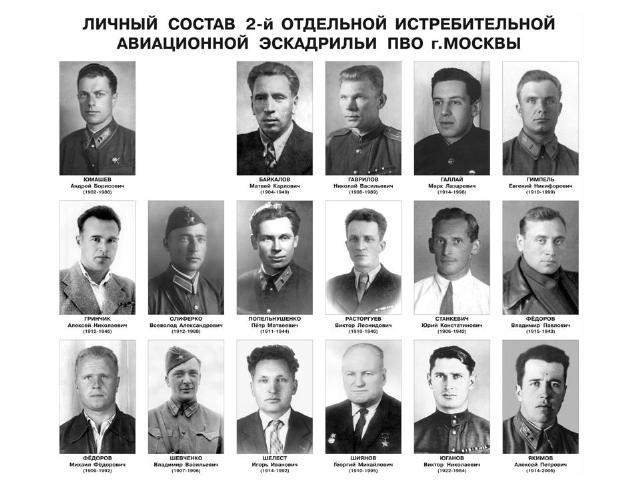 |
| Personnel of the 2nd separate Fighter squadron. |
| Source: Valery Ageev |
On the night of July 22, 1941, German aircraft carried out the first massive night raid on Moscow. It lasted from 22:25 on July 21 to 3:25 on July 22 and was carried out in four consecutive trains. 197 enemy bombers participated in the raid.
During the repulse of the first enemy raid on the capital, 22 enemy aircraft were shot down, two of which were accounted for by the test pilots of the LII. M.K. Baykalov shot down a Heinkel He-111, which fell in the Presnya area, and M.L. Gallai damaged a Dornier Do-17, which fell in the early morning between Vitebsk and Smolensk.
By decree of the Presidium of the Supreme Soviet of the USSR dated July 24, 1941, Matvey Karlovich Baykalov and Mark Lazarevich Gallai were awarded the Order of the Red Banner and became the first order bearers among the staff of the newly formed Institute.
The LII airfield services provided night flights of Ep-2, Il-4, Pe-8 and B-25 Mitchell aircraft deep behind enemy lines. From September 1941 to February 1943, the 565th Air Defense Fighter Aviation Regiment was also based at the airfield, flying I-153 and MiG-3 fighters.
From the autumn of 1941, the Institute's airfield became a jump airfield for long-range bombers based in the city of Ivanovo, and from April 1942 to May 1944 it was the main base of the 45th Long-range Aviation Division and other long-range aviation formations.
Flight to Berlin
So, in particular, on August 10, 1941, the polar pilot E.K. Pusep, under the command of Mikhail Vodopyanov, made the first combat flight on a Pe-8, successfully bombing Berlin.
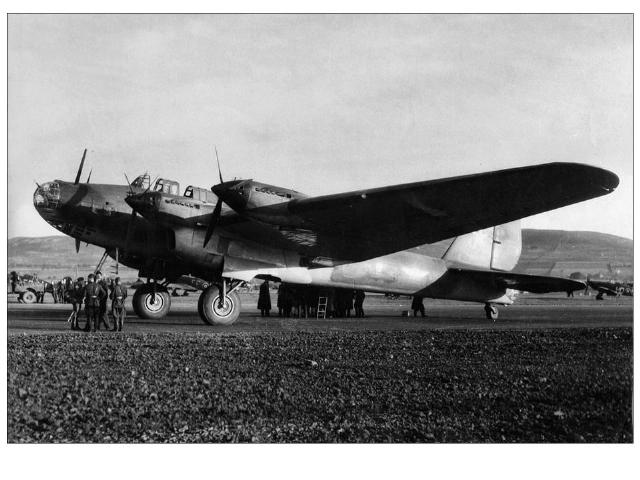 |
| Pe-8. |
| Source: Valery Ageev |
Upon returning to base, Vodopyanov's plane, in which Pusep was the co-pilot, was damaged by enemy anti-aircraft guns: fuel leaked from the punctured gas tank.
M. V. Vodopyanov made an emergency landing in German-occupied Estonia. E. K. Pusep was in his ancestral homeland for the first time. After leaving the damaged plane, the crew met a terrified shepherd boy; thanks to Pusep, who did not forget the Estonian language, the pilots were able to learn from him the way to the front line and returned to their own, avoiding capture.
By April 1942, Endel Pusep had flown 30 night sorties, bombing Berlin, Danzig and Konigsberg.
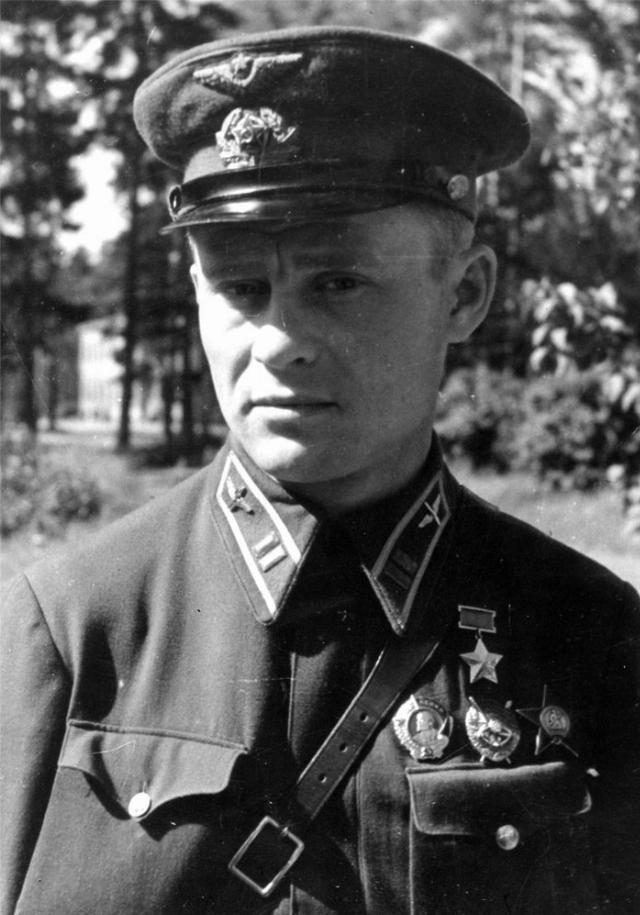 |
| Endel Pusep. |
| Source: Valery Ageev |
V. M.'s visit. Molotov to England and the USA
In May 1942, Pusep was entrusted to fly a Pe-8 with a special government mission. The bomber's crew: Commander E.K.Pusep, co-pilot V. M. Obukhov, navigators captains A. P. Shtepenko and S. M. Romanov, delivered a government delegation of the USSR headed by People's Commissar for Foreign Affairs V. M. Molotov to England and the United States to negotiate the opening of a second front in Europe.
In order to carry out this mission, additional fuel tanks and oxygen cylinders were installed on the Pe-8 bomber. Passenger seats in the form of stools were temporarily placed in the central compartment. According to the memoirs of the flight participants, the soft passenger seats were installed only during the intermediate landing in Scotland. The passengers, including women, were dressed in fur overalls and provided with oxygen masks.
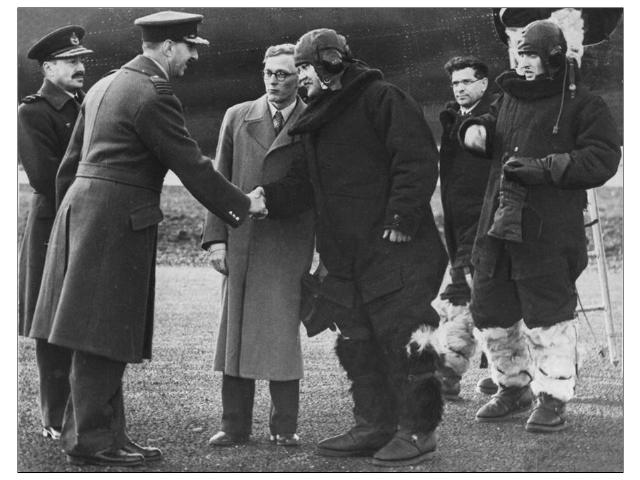 |
| V. M. Molotov's visit to England and the USA. |
| Source: Valery Ageev |
In long-range aviation, there were cases when bomber crew members accidentally squeezed the tubes of oxygen masks and they fell asleep, lost consciousness and died of hypoxia. Therefore, one of the flight gunners, D.M. Kozhin, checked all members of the delegation every 15 minutes, and there were 11 of them, for lack of sleep, and all this lasted for 10 hours of the flight. And for good reason. On the way, one of the passengers became ill and tried to remove her oxygen mask, but the flight gunner did not allow her to do so. The temperature outside reached -40 °C, and it was also cold in the makeshift passenger cabin.
On May 20, 1942, at 4:55 a.m. after 10:00 a.m. flight, having covered 2,700 kilometers, the Pe-8 landed at Teeling Airfield in Scotland. Here, armored plates and armor plates were removed from the aircraft to reduce flight weight, and one set of ammunition was left for the onboard cannons and machine guns. Additionally, the aircraft was equipped with two inflatable boats (clipper bots), and all crew members and passengers were provided with inflatable life jackets.
This was followed by the Reykjavik airfield (Iceland). Upon arrival, it turned out that there was no connection with America – we would have to wait and postpone the flight. By nightfall, the connection was restored, but it turned out that the weather on the route was non-flying.
Fateful meeting
On one of the days of his stay at the Reykjavik airfield, E.K. Pusep had a conversation with the American Colonel Arnold. Over a beer, the colonel said that the weather in the area of Tender airfield on the island of Newfoundland often changes.
We were silent, Pusep recalled, and smoked. We had another beer. Then Arnold rummaged in his card holder and pulled out his flight card. He spread it out on the table and pointed with his finger at a hand-drawn red circle south of Lake Medville, located on the Labrador Peninsula.
– Goose Bay. The airfield. Although it is far from Newfoundland, it can be useful on occasion. True, only one runway is ready there now, but its length – 5,820 feet (1,800 meters) – is quite sufficient for your aircraft. There is gasoline and oil there. There are also sleeping bags, canned food and hot coffee. Well, whiskey, too, he finished, smiling.
After finishing my beer and thanking my friendly American colleague for a pleasant conversation, I hurried back to my room. I found my map and, having found Lake Medville there, put a circle to the south of it.
We took off from Reykjavik at midnight on May 28-29. Already on the approach to the mainland, the Gander airfield designated for landing was indeed covered by fog, so the reserve airfield unexpectedly suggested by the American pilot for the Pe-8 crew turned out to be very useful.:
After staying in Goose Bay for a short time and preparing the ship for a new flight, we took off and headed for Washington. As we approached Washington, the temperature outside kept rising. The engines began to overheat and engine oil began to pour out of the hoods along the wing. Soon, the third engine was turned off, as its candles burned out. After a while, the gas was removed from another engine. So, on two and a half engines, 7 hours and 50 minutes after takeoff, we flew from Goose Bay airfield and landed on one of the airfields in Washington on the morning of May 30, flying 4,700 kilometers in 15 hours and 22 minutes. The Moscow–USA route took almost 11 days, with a flight time of 30 hours and 46 minutes.
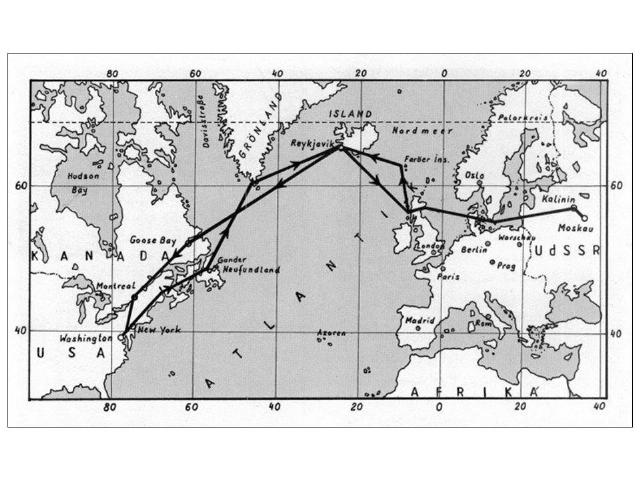 |
| V. M. Molotov's visit to England and the USA. |
| Source: Valery Ageev |
For the performance of this flight, the entire bomber crew was awarded military awards. The ship's commander E.K.Pusep, navigators A.P.Shtepenko and S.M. Romanov were awarded the title of Heroes of the Soviet Union. Co-pilot V.M.Obukhov, flight technicians A.Ya.Zolotarev and V.I. Dmitriev were awarded the Order of Lenin.
Valery Ageev
